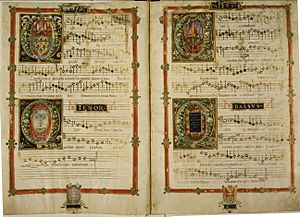Costanzo Festa facts for kids
Costanzo Festa (born around 1485/1490 – died April 10, 1545) was an Italian composer from the Renaissance period. He is most famous for his madrigals. He also wrote sacred vocal music, which is music for voices, often for church. Festa was the first Italian composer of polyphony (music with many independent voice parts) to become famous internationally. He was also one of the first to write madrigals, a very popular type of Italian song in the 1500s.
Life of Costanzo Festa
Not much is known about Costanzo Festa's early life. He was probably born in the Piedmont region, near Turin, Italy. Records suggest he was a "secular cleric," meaning he was a church official but not a monk. His birth year is thought to be in the late 1480s. He might have been related to another early madrigal composer, Sebastiano Festa, who was a bit younger.
His earliest known piece of music is a motet (a type of sacred song) called Quis dabit oculis. He wrote it in early 1514 when the Queen of France, Anne of Brittany, died. This shows he was already composing music by then.
In 1514, Festa visited Ferrara, bringing some of his motets. He was already seen as an important composer. Around this time, or a bit earlier, he lived on Ischia, an island near Naples. There, he taught music to the d'Avalos family. In 1517, he moved to Rome. He started working for Pope Leo X as a singer in the Sistine Chapel choir. He stayed with the choir for nearly 30 years.
Festa continued to compose many pieces. Some of his madrigals are among the very first ever written, possibly from the mid-1520s. He tried to get a Venetian printer to publish his church music in 1536, but it didn't work out. However, a Roman company published a book of his madrigals in 1538. In 1537, a Venetian company printed a collection of his madrigals for three voices.
Many of Festa's works can be dated exactly. This is because they were written for specific events like weddings, visits, or deaths. For example, he wrote a motet protesting the 1527 sack of Rome. He also composed music for a Medici wedding in 1539.
A note from 1543 says that Festa was too sick to travel with the Pope. He died in Rome in 1545.
Music and Influence
Costanzo Festa was one of the few Italian composers in the Papal Choir. Most of the musicians there were from northern Europe. Festa was very skilled in the Netherlands style of counterpoint (a way of combining melodies). He was important because he helped bring together the Italian and Netherlandish music styles. He also influenced Palestrina, a very famous composer who copied many of Festa's early works.
Most of Festa's madrigals were written for three voices. Other early madrigal composers often wrote for more voices. Festa liked fast, lively parts in his madrigals. He also wrote long sections where all the voices sang the same rhythm, which is called homophony. This was different from the more complex, imitative style found in motets.
Besides his madrigals, several collections of Festa's sacred music were published. These included four masses, over forty motets, and many Magnificats (songs praising Mary). His sacred music also had a simpler, more homophonic style. This might have been because Rome was musically conservative at the time.
Festa also wrote music for instruments. His most famous instrumental work is a huge study on a popular tune called La Spagna. He wrote 125 variations using this tune. This work shows off nearly every counterpoint technique known at the time. It includes canons (where melodies imitate each other), different numbers of voices (from 2 to 11), and complex rhythms. This amazing study, also called I bassi, could be played on many different instruments. It is considered a masterpiece of the Renaissance.
Festa's fame is also shown by his mention in a book called Gargantua and Pantagruel by François Rabelais. In the book, Festa is listed among the most famous musicians of his time.
See also
 In Spanish: Costanzo Festa para niños
In Spanish: Costanzo Festa para niños


